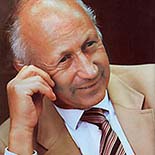 Norman Cousins was an American political journalist (June 24, 1915 – November 30, 1990), author, professor, and world peace advocate.
Norman Cousins was an American political journalist (June 24, 1915 – November 30, 1990), author, professor, and world peace advocate.
Cousins was born to Jewish immigrant parents Samuel Cousins and Sarah Babushkin Cousins, in West Hoboken, New Jersey (which later became Union City). At age 11, he was misdiagnosed with tuberculosis and placed in a sanatorium. Despite this, he was an athletic youth, and he claimed that as a young boy he “set out to discover exuberance.”
He joined the staff of the New York Evening Post (now the New York Post) in 1934, and in 1935 was hired by Current History as a book critic. He later ascended to the position of managing editor. He also befriended the staff of the Saturday Review of Literature (later renamed Saturday Review), which had its offices in the same building, and by 1940, joined the staff of that publication as well. He was named editor-in-chief in 1942, a position he would hold until 1972. Under his direction, circulation of the publication increased from 20,000 to 650,000.
Cousins joined the University of California, Los Angeles faculty in 1978 and became an adjunct professor in the Department of Psychiatry and Biobehavioral Sciences. He taught ethics and medical literature. His research interest was the connection between attitude and health.
Cousins did research on the biochemistry of human emotions, which he long believed were the key to human beings’ success in fighting illness. It was a belief he maintained even as he battled in 1964 a sudden-onset case of a crippling connective tissue disease, which was also referred to as a collagen disease. Experts at Dr. Rusk’s rehabilitation clinic confirmed this diagnosis and added a diagnosis of ankylosing spondylitis. Told that he had one chance in 500 of recovery, Cousins developed his own recovery program. He took massive intravenous doses of Vitamin C and had self-induced bouts of laughter brought on by films of the television show Candid Camera and by various comic films. His positive attitude was not new to him, however. He had always been an optimist, known for his kindness to others, and his robust love of life itself. “I made the joyous discovery that ten minutes of genuine belly laughter had an anesthetic effect and would give me at least two hours of pain-free sleep,” he reported. “When the pain-killing effect of the laughter wore off, we would switch on the motion picture projector again and not infrequently, it would lead to another pain-free interval.” His struggle with that illness and his discovery of laugh therapy[14] is detailed in his 1979 book Anatomy of an Illness as Perceived by the Patient.
Later in life, he and his wife, Ellen, together fought his heart disease, again with exercise, a daily regimen of vitamins, and the good nutrition provided by Ellen’s organic garden. He wrote a collection of best-selling non-fiction books on illness and healing, as well as a 1980 autobiographical memoir, Human Options: An Autobiographical Notebook.